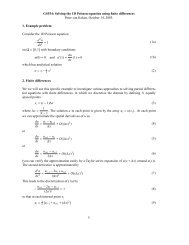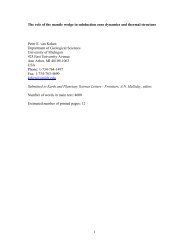Quantitative paleoenvironmental and paleoclimatic reconstruction ...
Quantitative paleoenvironmental and paleoclimatic reconstruction ...
Quantitative paleoenvironmental and paleoclimatic reconstruction ...
Create successful ePaper yourself
Turn your PDF publications into a flip-book with our unique Google optimized e-Paper software.
ARTICLE IN PRESS<br />
34 N.D. Sheldon, N.J. Tabor / Earth-Science Reviews xxx (2009) xxx–xxx<br />
Table 6<br />
Age, δ 13 C <strong>and</strong> concentration (X m ) of Fe(CO 3 )OH in solid solution in goethite, <strong>and</strong><br />
estimated atmospheric pCO 2 (PAL; PAL =300 ppmV).<br />
Epoch<br />
~Age<br />
(Ma)<br />
δ 13 C<br />
(‰)<br />
X m<br />
Atm.<br />
pCO 2<br />
Source<br />
Late Ordovician 440 −17.6 0.00645 16 Yapp <strong>and</strong> Poths (1993)<br />
Late Devonian 360 −21.5 0.0175 1 Yapp <strong>and</strong> Poths (1996)<br />
Early Permian 283 −13.5 0.0090 1 Tabor et al. (2004a,b)<br />
Early Permian 270 −13.9 0.0083 1 Tabor et al. (2004a,b)<br />
Early Jurassic 195 −15.3 0.0097 18 Yapp <strong>and</strong> Poths (1996)<br />
Early Middle 185 −15.0 0.0088 18 Yapp <strong>and</strong> Poths (1996)<br />
Jurassic<br />
Late Middle 165 −17.2 0.0120 1 Yapp <strong>and</strong> Poths (1996)<br />
Jurassic<br />
Late Middle 165 −17.3 0.0099 1 Yapp <strong>and</strong> Poths (1996)<br />
Jurassic<br />
Late Cretaceous 80 −19.7 0.0103 4 Yapp <strong>and</strong> Poths (1996)<br />
Paleocene 60 −20.1 0.0067 8±4 Tabor <strong>and</strong> Yapp (2005a)<br />
Early Eocene 52 −20.1 to 0.0014–0.0064 7 Tabor <strong>and</strong> Yapp (2005a)<br />
−15.4<br />
Late Tertiary 5 −21.7 0.0108 1 Yapp <strong>and</strong> Poths (1996)<br />
then paleosol calcite δ 13 C values may prove an important source of<br />
information about the concentration of total soil pCO 2 , which is<br />
known to be strongly correlated with evapotranspiration <strong>and</strong> soil<br />
productivity (e.g., Brook et al., 1983). As mentioned earlier, modern<br />
soil-forming environments that are characterized by precipitation of<br />
calcite are generally low-productivity soils, with total soil pCO 2<br />
usually no greater than ~10,000 ppmV. Note however, that this very<br />
low range of soil pCO 2 also reflects that modern tropospheric pCO 2 is<br />
low, <strong>and</strong> contributes very little (~300 ppmV) to total soil pCO 2 .For<br />
times when tropospheric pCO 2 was significantly higher than modern<br />
(e.g., ~2000–3000 ppmV; Eocene, Paleocene, Cretaceous; Yapp <strong>and</strong><br />
Poths, 1996; Yapp, 2004; Tabor <strong>and</strong> Yapp, 2005a), soil pCO 2 in calcareous<br />
soils likely had a correspondingly higher concentration. In this<br />
regard, subtraction of atmospheric pCO 2 values yields the concentration<br />
of CO 2 in the soil that is derived only from oxidation of biological<br />
materials (C B ; Yapp <strong>and</strong> Poths, 1996). Brook et al. (1983) reported a<br />
least squares variance (R 2 =0.81) between soil productivity (as<br />
specified by soil pCO 2 ) <strong>and</strong> actual evapotranspiration, where actual<br />
evapotranspiration is the quantity of soil water that is released from<br />
the soil as water vapor through evaporation <strong>and</strong> transpiration. In this<br />
regard, paleosol calcite δ 13 C values may prove useful as a quantitative<br />
proxy to assess aridity among populations of calcite-bearing paleosols;<br />
this includes soils that are ambiguously assigned to subhumid, semiarid,<br />
<strong>and</strong> arid climates.<br />
7.4.3.3. Pedogenic goethite. The common low-temperature mineral<br />
goethite (α-FeOOH) occurs in solid solution with small amounts of a<br />
ferric carbonate component (Fe(CO 3 )OH). The molar concentration<br />
<strong>and</strong> δ 13 C composition of the Fe(CO 3 )OH component in goethite are<br />
measured with an incremental vacuum dehydration–decarbonation<br />
technique that requires vacuum extraction lines with extremely low<br />
background CO 2 values (see description of high-vacuum extraction<br />
system by Yapp <strong>and</strong> Pedley, 1985). The molar fraction of Fe(CO 3 )OH is<br />
very low, <strong>and</strong> therefore highly susceptible to contamination from<br />
carbon sources that might be added to the goethite. Therefore,<br />
goethites undergo a strict series of chemical pre-treatments prior to<br />
incremental dehydration–decarbonation analysis. Goethites are<br />
ground in reagent-grade acetone. The b63 μm fraction is then treated<br />
with 0.5–1.0 N HCl solution in order to remove calcite <strong>and</strong> thoroughly<br />
rinsed before several treatments with 30% H 2 O 2 are made in order to<br />
remove naturally occurring organics that may be sorbed to the surface<br />
of the goethite. Goethite samples that have undergone the preceding<br />
set of treatments are then analyzed in a set of incremental vacuum<br />
dehydration–decarbonation experiments, ranging from ~190 to<br />
240 °C, <strong>and</strong> CO 2 <strong>and</strong> H 2 O dehydroxylation-decarbonation products<br />
of goethite <strong>and</strong> Fe(CO 3 )OH are measured manometrically for their<br />
molar ratios <strong>and</strong> δ 13 C compositions. During the dehydration process,<br />
“plateau” values of incremental H 2 O:CO 2 ratios (called “F” ratios,<br />
which are twice that of “X” ratios) <strong>and</strong> δ 13 C values emerge (Yapp <strong>and</strong><br />
Poths, 1991, 1992, 1993; Hsieh <strong>and</strong> Yapp, 1999; Yapp, 2001a,b, 2004;<br />
Tabor et al., 2004b; Tabor <strong>and</strong> Yapp, 2005a). These plateau δ 13 C <strong>and</strong> F<br />
values correspond to the δ 13 C G <strong>and</strong> twice the X G values (described<br />
below), respectively.<br />
The molar concentration (X G ) <strong>and</strong> carbon isotope value (δ 13 C G )of<br />
the ferric carbonate component is a function of the concentration <strong>and</strong><br />
δ 13 C, respectively, of the CO 2 present during crystallization of goethite<br />
(Yapp, 1987a,b, 2001a,b, 2004; Yapp <strong>and</strong> Poths, 1991, 1992, 1993, 1996;<br />
Tabor et al., 2004a,b). Two-component CO 2 mixing in the presence of<br />
soil goethite crystallization involves CO 2 from the atmosphere <strong>and</strong> CO 2<br />
from oxidation of organic matter in the soil. Thus, the Fe(CO 3 )OH<br />
component in goethites that form in such environments may preserve<br />
information on the partial pressure of CO 2 in the Earth's atmosphere<br />
as well as the ambient pCO 2 of soil gas. Yapp <strong>and</strong> Poths (1992) presented<br />
the following Henry's law equation that relates the molar<br />
concentration of Fe(CO 3 )OH in solid solution in goethite to the<br />
concentration of ambient CO 2 in the soil:<br />
Log pCO 2 =LogX G +6:04 − 1570<br />
T<br />
ð54Þ<br />
where X G is the mole fraction of Fe(CO 3 )OH in solid solution in goethite<br />
<strong>and</strong> T is temperature in K. If X G <strong>and</strong> T are known, then atmospheric<br />
pCO 2 may be determined from Eq. (54). X G may be determined from<br />
direct measurement of the Fe(CO 3 )OH in goethite, whereas temperature<br />
of goethite crystallization may be estimated from other proxies<br />
(see below). To date, reported X G values of 2-component goethites<br />
range from 0.0014 to 0.0175 (Table 6), which corresponds to soil pCO 2<br />
values ranging from ~20,000 to ~105,000 ppmV. Such high pCO 2<br />
values indicate humid, biologically productive soils consistent with<br />
intense chemical weathering <strong>and</strong> development of recalcitrant pedogenic<br />
minerals such Fe-Oxides (Tardy et al., 1990a,b).<br />
The equation that relates X G <strong>and</strong> δ 13 C G values of Fe(CO 3 )OH in solid<br />
solution in goethites that form in the presence of two soil CO 2<br />
components to atmospheric pCO 2 is similar to that of pedogenic<br />
calcite (Yapp <strong>and</strong> Poths, 1992, 1993, 1996):<br />
h<br />
i<br />
<br />
δ 13 C G = δ 13 C GA − δ 13 1<br />
C GO X GA + δ 13 C<br />
X GO ð55Þ<br />
G<br />
The subscript “G” indicates goethite. δ 13 C G is the measured δ 13 C<br />
value of Fe(CO 3 )OH in goethite, the δ 13 C values subscripted with “A”<br />
<strong>and</strong> “O” are defined in the manner for Eq. (52). X G is the measured mol<br />
fraction of the Fe(CO 3 )OH component, in the goethite, whereas the<br />
values X GA would be the molar fraction of Fe(CO 3 )OH if atmospheric<br />
CO 2 were the only CO 2 in the soil profile.<br />
Eq. (55) indicates that, in a plot of δ 13 C G vs. 1/X G , the Fe(CO 3 )OH<br />
component in goethite samples from the shallower portions of any<br />
particular soil yield a linear array with a positive slope from which an<br />
apparent pCO 2 for Earth's ancient atmosphere can be calculated (Yapp<br />
<strong>and</strong> Poths, 1992, 1993, 1996, Yapp, 2004; see Fig. 20).<br />
To date, Fe(CO 3 )OH in solid solution in paleosol goethites has<br />
provided estimates of paleoatmospheric pCO 2 from 12 different<br />
paleosol profiles ranging in age from Ordovician to Miocene<br />
(Table 6). This contrasts with several hundred estimates of paleoatmospheric<br />
pCO 2 from paleosol calcite (see, for example, Fig. 19). The<br />
relative paucity of paleoatmospheric pCO 2 estimates from Fe(CO 3 )OH<br />
in solid solution in paleosol goethites reflects that only a few research<br />
groups have focused on this proxy method, difficulty of analysis<br />
compared to paleosol calcite, <strong>and</strong> that paleosols with 2-component Fe<br />
Please cite this article as: Sheldon, N.D., Tabor, N.J., <strong>Quantitative</strong> <strong>paleoenvironmental</strong> <strong>and</strong> <strong>paleoclimatic</strong> <strong>reconstruction</strong> using paleosols, Earth-<br />
Science Reviews (2009), doi:10.1016/j.earscirev.2009.03.004















